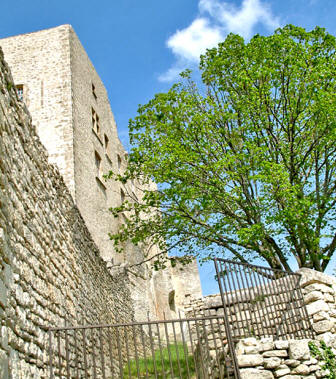|

Taking Kinky to the Next Level: The
Marquis de Sade
Donatien de Sade 1740-1814
In full, his name was
Donatien-Alphonse-François,
the Comte de Sade.
|
|
Or Louis-Aldonse
Donatien, also called
The Divine Marquis.
Image Above
Colombine checking
on Lisette who
might or might not have enjoyed a
nightly visit from the Marquis de Sade. The
pineapple is missing as well.
Let Them Eat Cake,
1999
French and Saunders |
De Sade in a
Nutshell
Donatien de Sade outraged his contemporaries by his sexual views, practices,
and writings. He had such an impact on the
subject that today's term sadism finds its roots with him.
De Sade's Family
His father was
Jean-Baptiste-Francois-Joseph,
Count de Sade. He died on January 24, 1767, at Montreuil,
aged 65. His son, Donatien, was his sole heir.
De Sade's first wife was Renée-Pélagie Cordier de Launay de Montreuil, born at Paris, on December 3, 1741.
His three children by his first
wife were two sons, Louis-Marie, Donatien-Claude-Armand, and one
daughter, Madeleine-Laure.
Louis-Marie de Sade,
was born at Paris, on August 27, 1767.
Donatien-Claude-Armande de Sade
was born at Paris, on June 27, 1769.
Madeleine-Laure de Sade
was born on April 17, 1771.
De Sade's Life —
The Quiet Years
De Sade was born on June 2,
1740, at Paris, France. He was of noble birth.
In 1754 or 1755, de Sade joined
the military and fought in the
 Seven Years' War.
Seven Years' War.
On May 15, 1763, and while
in love with Mademoiselle
Laure de Lauris, de
Sade married
Mademoiselle Renée-Pélagie Cordier de Launay de Montreuil.
De Sade's Life —
The Scandal Years
On October 29, 1763, the King
ordered de Sade to the fortress at Vincennes because of excess in a brothel
which he had been frequenting for a month.
On November 13, 1763, de Sade was
free to go, but the King stipulated that he had to stay at,
and or in close proximity to, the château Echauffour, in Normandy.
In May 1764, the King made an
exception and sent de
Sade to Dijon on official business. In September, he
officially revoked the orders regarding Echauffour. De Sade
was again free to go wherever he pleased.
A December 7, 1764, police
report reads that it was asked "to refrain from providing
the Marquis with girls to go to any private chambers with
him."
In 1765, de Sade's girlfriend was the actress Mademoiselle Beauvoisin.
On April 16, 1767, de Sade was
promoted captain commander in the cavalry. On April 20,
he left for Lyon.
The Rose Keller
Affair
On April 3, 1768, de Sade met
a certain Rose Keller. She accompanied him to his cottage
and didn't enjoy the experience as much as he did. Rose escaped and
told the authorities.
On April 7, 1768, de Sade's wife
managed to get Rose Keller to accept a bunch of
money in return for her dropping a bunch of charges.
But rumors persisted and
eventually caused the Paris
Council to take a second look at the evidence. On April 23, 1768, the Paris
Council declared de Sade under arrest.
On April 30, 1768, de Sade was
transferred from Saumur castle to Pierre-Encise prison near
Lyons.
Interrogated on June 10, 1768, de Sade admitted to the allegations but claimed that
Rose Keller liked it too.
On November 16, 1768, and per
Royal Order, de Sade was again free to go. But it was recommended that he should retire to his
castle at La Coste.

Ruins of
Chateau Lacoste Today
Photo: ArjenW / Wiki
Brief Note on Lacoste
The small town of Lacoste, with 400
souls and located in the Vaucluse department, South of France, is
overlooked by the ruins of the Chateau La Coste. Occupation
at this address dates back to Roman times.
In 1716,
Isabelle Simiane bequeathed the castle to her
cousin, Gaspard François de Sade,
Seigneur de Saumane et de Mazan, who was the
grandfather of our hero, Donatien-Alphonse-François de Sade.
In 1766, de Sade began
restorations and beautifications of the estate.
The chateau was
pillaged during the
 Revolution and afterwards sold to the
Marquis de Rovère.
Revolution and afterwards sold to the
Marquis de Rovère.
In 1816, Rovere's widow sold the
château, by now a heap of ruins, to a farmer,
Pierre Grégoire. Pierre,
in turn, sold it to a local bricklayer,
Jean Cyprien. The bricks of the castle became consequently
part of many
houses in the village.
From 1952 until his death,
André Bouer, college
professor, became the new owner and devoted his life to the castle's restoration.
|
In
2001, Paris fashion designer
Pierre
Cardin, born 1922, bought the castle.
After
investing a heap of money,
Cardin is hosting the annual Festival de
Lacoste.
|

Pierre Cardin is the
Proud Owner
of de Sade's Chateau
Photo:
AFP / The Independent |
|
In
addition to the castle on the
hill-top, Cardin bought, so far, more than 40 houses
downtown. All in all, Cardin is
said to have pumped over 30 million
Euros into the Lacoste village,
while getting the utter kick out of his
little Project Provençal. |

Chateau
Lacoste
Photo:
Pierre Cardin
Back to the life of the Marquis
de Sade.
De Sade's Life
From 1770
In August 1770, de Sade returned
to his regiment in Burgundy.
On March 19, 1771, he
was made colonel.
On September 9, 1771, de Sade
left Fort l'Eveque prison, where he had spent a week for
being in debt.
De Sade had written a comedy
which was performed at the local theater at La Coste on
January 20, 1772.

Chateau
Lacoste
Photo:
Pierre Cardin
The Marseille
Disaster
On June 27, 1772, while on a
visit to Marseille, de Sade
enjoyed a party with his manservant
Armand Latour and
several girls, whom he offered free access to some goodies
that contained cantharides, aka Spanish Fly, in other words
dried bugs, but considered an aphrodisiac. The girls got
sick and reported to the
police that they had been poisoned.
On July 4, 1772, the Royal
Prosecutor decreed the arrest of de Sade and Latour. They,
in turn, fled town. Meanwhile, the pharmacists
involved in the investigation didn't find any arsenic,
neither in the candy box, nor in the former content of the
girls' stomachs.
On September 3, 1772, de Sade and Latour were sentenced to
death for sodomy and poisoning.
On the run, de Sade and Latour left Nice
behind and arrived at Chambery on October 27, 1772. Traveling
along was another man named Carteron and de Sade's
sister-in-law, Lady Anne.
On December 8, 1772, de Sade and
Latour were arrested at Chambery and transferred
to Fort Miolans prison, thanks to Lady de Montreuil, de Sade's mother-in-law,
who blew the whistle. De Sade's wife tried desperately to get them out of this
mess.
On April 30, 1773, de Sade and
Latour, together with another prisoner, escaped and made it to Grenoble.
On December 16, 1773, new court
orders were issued for the arrest of de Sade, who in turn
laid low for a while.
The Young Girls
Scandal
In January 1775, de Sade made new headlines
with the young girls scandal. Several young females had been
hired as servants and things had gotten out of hand. Now
the families of the girls started criminal proceedings from all
directions.
On May 3, 1775, authorities
informed de Sade's
relatives that he (de Sade) "indulged in
excesses of every kind with young people of both sexes whom
he kidnaps."
Returning Home
In August 1775, de Sade was
traveling across Italy under the name
Count de Mazan, but he was itching to go home.
In June 1776, de Sade arrived at
Grenoble, and on July 26, he was back at La Coste.

Château La
Coste
Photo: Mairie & Office de
Tourisme Lacoste
On January 14, 1777,
Marie-Eléonore de Maillé de Carman, Dowager Countess de Sade,
Donatien's mother, died at the
Carmelite convent at Paris, aged 65.
On February 13, 1777, de Sade was
arrested by Inspector Marais at the Hotel de Danemark in
Paris. He was imprisoned at the Vincennes fortress.
On May 23, 1778, de Sade decided
to plea for insanity before the High
Court of Provence. Escorted by Inspector Marais, he left for Aix-en-Provence on June
14, and arrived on June 20, 1778. On July 14, 1778, de Sade
was
found guilty by the High Court of Aix for debauchery and
excessive libertinage.
On their way to prison, de Sade
and his travel companions spent the night of July 16, 1778, at Valence, where
he managed to escape. He fled direction Avignon, then to La Coste again, which was a mistake.
On August 26, 1778, a mob forced
de Sade's door and took him to Vincennes, where he arrived
on September 7, 1778, again a prisoner.
On May 13, 1781, Lady Anne died.
Smallpox.
On February 29, 1784, de Sade
was transferred from Vincennes to the
 Bastille. On March 8, 1784, de Sade
wrote in a letter to his wife that the conditions at the Bastille
were far worse than at Vincennes.
Bastille. On March 8, 1784, de Sade
wrote in a letter to his wife that the conditions at the Bastille
were far worse than at Vincennes.
On May 25, 1787, Madame de Sade
wrote to Gaufridy that "Monsieur de Sade is in fair health
but getting very fat."
The Bastille logbook reads under July 2, 1789, that
"The Count de Sade shouted several times
from the window of the Bastille that the prisoners were
being slaughtered and that the people should come to
liberate them."
On July 4, 1789, just shortly before the
 Storm of the
Bastille on July 14, 1789, de Sade was transferred to Charenton, an asylum for the insane. His
wife was to fetch his belongings from his former cell, but
the Revolutionaries did it before she got the opportunity.
Storm of the
Bastille on July 14, 1789, de Sade was transferred to Charenton, an asylum for the insane. His
wife was to fetch his belongings from his former cell, but
the Revolutionaries did it before she got the opportunity.
De Sade was released on April 2,
1790. Madame de Sade informed him that she was
seeking a separation.
In August 1790, de Sade connected
with Marie-Constance Renelle.
In 1791, de Sade wrote his novel
Justine.
In September 1792, a mob
ransacked de Sade's chateau at La Coste.

Château La
Coste
Photo: Mairie & Office de
Tourisme Lacoste
On January 21, 1792,
 Louis Capet,
the King,
was guillotined.
Louis Capet,
the King,
was guillotined.
On December 8, 1793, de Sade was
arrested at his house in Paris on the rue Neuve-des-Mathurins and
taken to Madelonnettes, former convent now prison. This time around, the problem
was a letter de Sade had written two years earlier.
On January 13, 1794, de Sade
was transferred to the Carmelite convent on the rue de Vaugirard.
On January 22, 1794, de Sade was
transferred to the Saint-Lazare prison where he had to stay
at the prison hospital because he was sick. He was again
free to go in October 1794.
De Sade was back in Charenton in
1801.
On December 2, 1814, de Sade
died while still at Charenton.

Donatien-Alphonse-François
de Sade
De Sade's Works
Justine, ou les malheurs de la
vertu
(1791)
Juliette
(1798)
La philosophie dans le boudoir
(1793)
Les crimes de l'amour
(1800)
More History
|